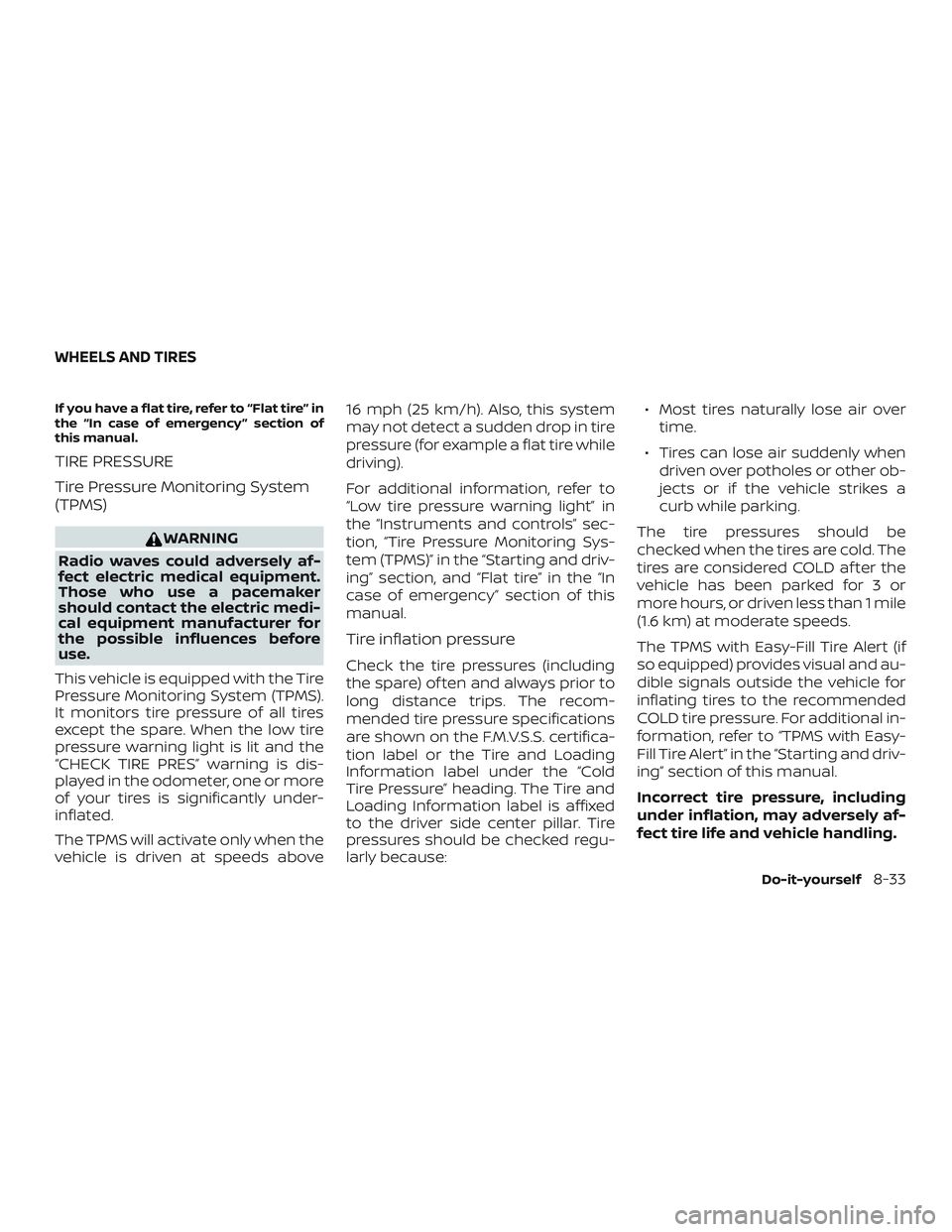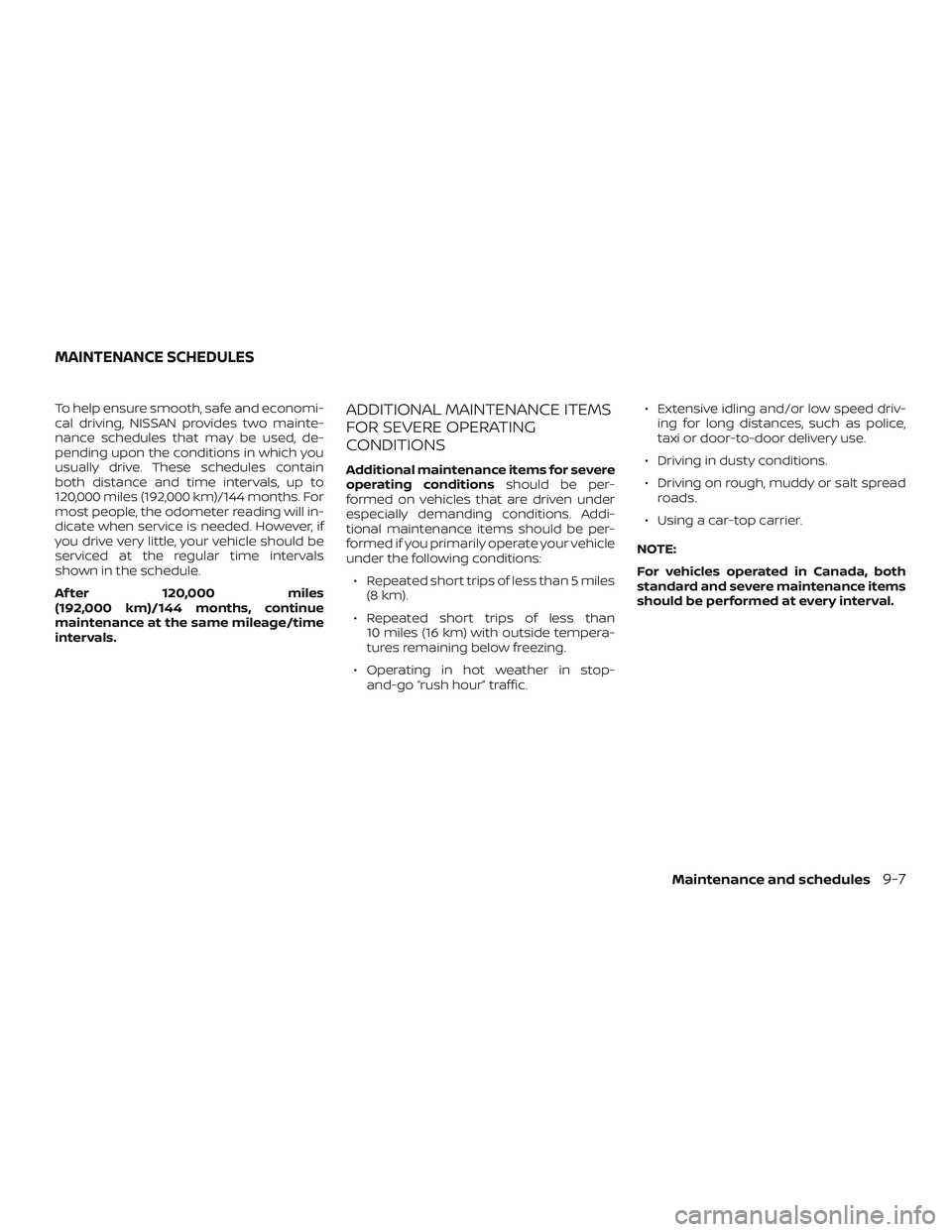2019 NISSAN VERSA odometer
[x] Cancel search: odometerPage 309 of 372

If you have a flat tire, refer to “Flat tire” in
the “In case of emergency ” section of
this manual.
TIRE PRESSURE
Tire Pressure Monitoring System
(TPMS)
WARNING
Radio waves could adversely af-
fect electric medical equipment.
Those who use a pacemaker
should contact the electric medi-
cal equipment manufacturer for
the possible influences before
use.
This vehicle is equipped with the Tire
Pressure Monitoring System (TPMS).
It monitors tire pressure of all tires
except the spare. When the low tire
pressure warning light is lit and the
“CHECK TIRE PRES” warning is dis-
played in the odometer, one or more
of your tires is significantly under-
inflated.
The TPMS will activate only when the
vehicle is driven at speeds above 16 mph (25 km/h). Also, this system
may not detect a sudden drop in tire
pressure (for example a flat tire while
driving).
For additional information, refer to
“Low tire pressure warning light” in
the “Instruments and controls” sec-
tion, “Tire Pressure Monitoring Sys-
tem (TPMS)” in the “Starting and driv-
ing” section, and “Flat tire” in the “In
case of emergency” section of this
manual.
Tire inflation pressure
Check the tire pressures (including
the spare) of ten and always prior to
long distance trips. The recom-
mended tire pressure specifications
are shown on the F.M.V.S.S. certifica-
tion label or the Tire and Loading
Information label under the “Cold
Tire Pressure” heading. The Tire and
Loading Information label is affixed
to the driver side center pillar. Tire
pressures should be checked regu-
larly because: ∙ Most tires naturally lose air over
time.
∙ Tires can lose air suddenly when driven over potholes or other ob-
jects or if the vehicle strikes a
curb while parking.
The tire pressures should be
checked when the tires are cold. The
tires are considered COLD af ter the
vehicle has been parked for 3 or
more hours, or driven less than 1 mile
(1.6 km) at moderate speeds.
The TPMS with Easy-Fill Tire Alert (if
so equipped) provides visual and au-
dible signals outside the vehicle for
inflating tires to the recommended
COLD tire pressure. For additional in-
formation, refer to “TPMS with Easy-
Fill Tire Alert” in the “Starting and driv-
ing” section of this manual.
Incorrect tire pressure, including
under inflation, may adversely af-
fect tire life and vehicle handling.
WHEELS AND TIRES
Do-it-yourself8-33
Page 327 of 372

To help ensure smooth, safe and economi-
cal driving, NISSAN provides two mainte-
nance schedules that may be used, de-
pending upon the conditions in which you
usually drive. These schedules contain
both distance and time intervals, up to
120,000 miles (192,000 km)/144 months. For
most people, the odometer reading will in-
dicate when service is needed. However, if
you drive very little, your vehicle should be
serviced at the regular time intervals
shown in the schedule.
Af ter 120,000 miles
(192,000 km)/144 months, continue
maintenance at the same mileage/time
intervals.ADDITIONAL MAINTENANCE ITEMS
FOR SEVERE OPERATING
CONDITIONS
Additional maintenance items for severe
operating conditionsshould be per-
formed on vehicles that are driven under
especially demanding conditions. Addi-
tional maintenance items should be per-
formed if you primarily operate your vehicle
under the following conditions:
∙ Repeated short trips of less than 5 miles (8 km).
∙ Repeated short trips of less than 10 miles (16 km) with outside tempera-
tures remaining below freezing.
∙ Operating in hot weather in stop- and-go “rush hour” traffic. ∙ Extensive idling and/or low speed driv-
ing for long distances, such as police,
taxi or door-to-door delivery use.
∙ Driving in dusty conditions.
∙ Driving on rough, muddy or salt spread roads.
∙ Using a car-top carrier.
NOTE:
For vehicles operated in Canada, both
standard and severe maintenance items
should be performed at every interval.
MAINTENANCE SCHEDULES
Maintenance and schedules9-7
Page 361 of 372

Engine oil...................8-7
F.M.V.S.S. certification label .........10-12
Foglightswitch ................2-27
Front air bag system
(See supplemental restraint system) . . .1-52
Front-door pocket ...............2-29
Frontseats....................1-2
Fuel Capacities and recommended
fuel/lubricants...............10-2
Fuel economy ...............5-27
Fuel-filler cap ................3-30
Fuel-filler door lock opener lever ....3-30
Fuel-filler lid .................3-30
Fuel gauge ..................2-9
Fueloctanerating.............10-6
Fuel recommendation ..........10-4
Loose fuel cap warning ..........2-7
Fuelefficientdrivingtips...........5-26
Fuel-filler door .................3-30
Fuel gauge ....................2-9
Fuses .......................8-19
Fusiblelinks...................8-20
G
Gascap.....................3-30
Gauge Engine coolant temperature gauge . .2-9
Fuel gauge ..................2-9
Odometer ..................2-6
Speedometer ................2-5
Tachometer .................2-8
Trip computer ...............2-10 Trip odometer
.............2-5,2-6
General maintenance .............9-2
Glovebox ....................2-31
H
Hands-free phone system, Bluetooth® . .4-46
Hazard warning flasher switch ........6-2
Headlight and turn signal switch ......2-24
Headlightcontrolswitch...........2-24
Headlights ...................8-26
Headrestraints .................1-6
Heater Heater and air conditioner controls . .4-14
Heater operation ..............4-16
Hood .......................3-27
Horn.......................2-27
I
Ignition switch ..................5-9
Push-button ignition switch .......5-11
Immobilizer system ...........2-21,5-14
Important vehicle information label . . .10-12
Increasing fuel economy ...........5-27
Indicator NISSAN Intelligent Key® battery discharge
indicator...................5-13
Indicator lights and audible reminders
(See warning/indicator lights and audible
reminders) ....................2-18
Instrument brightness control .......2-26
Instrument panel .............0-6,2-2 Instrument panel dimmer switch
.....2-26
Intelligent Key system Key operating range ............3-14
Key operation ................3-16
Mechanical key ...............3-5
Remote keyless entry operation ....3-19
Troubleshooting guide ..........3-25
Warning signals ..............3-25
Interiorlight...............2-34,2-35
Interiortrunklidrelease...........3-29
iPod®Player...................4-35
ISOFIX child restraints .............1-23
J
Jumpstarting...............6-9,8-14
K
Key.........................3-2
K e
y fob battery replacement .....8-22,8-23
Keyless entry With Intelligent Key system
(See Intelligent Key system) .......3-19
Without Intelligent Key system
(See remote keyless entry system). . .3-10
Keys NISSAN Intelligent Key® .......3-4,3-13
NISSAN Vehicle Immobilizer System
keys..................... .3-5
11-3
Page 362 of 372

L
Labels Air conditioner specification label . . .10-13
Emission control information label . .10-12
Engine serial number ..........10-12
F.M.V.S.S. certification label .......10-12
Tire and Loading Information label . .10-13
Vehicle identification number (VIN) . .10-11
Vehicle identification number (VIN)
plate.....................10-11
Warning labels (for SRS) .........1-60
LATCH (Lower Anchors and Tethers for
CHildren)System............... .1-23
Launch bar menu ................4-7
License plate Installing the license plate .......10-13
Light Airbagwarninglight ........1-61, 2-18
Brakelight(Seestoplight)........8-28
Bulb check/instrument panel ......2-13
Bulb replacement .............8-28
Charge warning light ...........2-14
ExteriorandInteriorlights........8-28
Foglights..................8-27
Foglightswitch ..............2-27
Headlight and turn signal switch ....2-24
Headlightcontrolswitch.........2-24
Headlights .................8-26
Interiorlight.............2-34,2-35
Lightbulbs.................8-26
Low tire pressure warning light .....2-15
Passenger air bag and status light. . .1-52
Security indicator light ..........2-20
Trunklight..................2-36 Warning/indicator lights and audible
reminders
..................2-18
Lights......................8-26 Maplights..................2-35
Lock Child safety rear door lock ........3-8
Door locks ................3-6,3-7
Fuel-filler door lock opener lever ....3-30
Power door locks ..............3-8
Trunk lid lock opener lever ........3-28
Loose fuel cap warning ............2-7
Lowfuelwarninglight ............2-15
Low tire pressure warning light .......2-15
Luggage
(See vehicle loading information) .....10-14
M
Maintenance General maintenance ...........9-2
Insidethevehicle..............9-3
Maintenance precautions .........8-2
Outsidethevehicle.............9-2
Seat belt maintenance ..........1-17
Under the hood and vehicle .......9-4
Maintenance log ................9-13
Maintenance requirements ..........9-2
Maintenance schedules ............9-7
Maintenance under severe operation
conditions....................9-12
Malfunctionindicatorlight..........2-19
Manual front seat adjustment ........1-3
Manual windows ................2-34
Maplights....................2-35
Menu button ...................4-5 Meters and gauges
...............2-3
Instrument brightness control .....2-26
Mirror Outsidemirrorcontrol..........3-34
Outsidemirrors..............3-34
Rearview...................3-34
Vanitymirror................3-33
Mirrors......................3-34
N
NissanConnect® Owner's Manual ......4-2
NISSAN Intelligent Key® .........3-4,3-13
NISSAN Intelligent Key® battery discharge
indicator.....................5-13
NISSAN Vehicle Immobilizer
System...................2-21, 5-14
O
Octane rating (See fuel octane rating) . .10-6
Odometer ....................2-6
Oil Capacities and recommended
fu
el/lubricants...............10-2
Changing engine oil ............8-8
Changing engine oil filter .........8-9
Checking engine oil level .........8-7
Engine oil ...................8-7
Engine oil and oil filter
recommendation .............10-7
Engine oil viscosity .............10-7
Outsidemirrorcontrol............3-34
Outsidemirrors................3-34
11-4
Page 364 of 372

Specifications..................10-9
Speedometer ..................2-5
SRS warning label ...............1-60
Stability control ................5-32
Standard maintenance ............9-8
Starting Before starting the engine ........5-14
Jumpstarting.............6-9,8-14
Precautions when starting and
driving .....................5-2
Push starting ................6-11
Starting the engine ............5-14
Starting the engine ..............5-14
Starting the engine (models with NISSAN
Intelligent Key® system) ...........5-15
Steering Power steering system ..........5-29
Tilting steering wheel ...........3-32
Steering wheel .................3-32
Steering wheel audio control switch . . .4-42
Stoplight....................8-28
Storage.....................2-29
Storagetray ..................2-30
Sunvisors....................3-33
Supplemental air bag warning labels . . .1-60
Supplemental air bag warning
light.................... .1-61, 2-18
Supplemental front impact air bag
system ..................... .1-52
Supplemental restraint system Information and warning labels . . . .1-60
Precautions on supplemental restraint
system ....................1-42
Supplemental restraint system
(Supplemental air bag system) .......1-42Switch
Automatic power window switch . . .2-34
Foglightswitch ..............2-27
Hazard warning flasher switch ......6-2
Headlight and turn signal switch ....2-24
Headlightcontrolswitch.........2-24
Ignition switch ................5-9
Instrument brightness control .....2-26
Power door lock switch ..........3-8
Rearwindowdefrosterswitch.....2-24
Turn signal switch .............2-26
T
Tachometer ...................2-8
Temperature gauge Engine coolant temperature gauge . .2-9
Thef t (NISSAN Vehicle Immobilizer System),
engine start ................2-21,5-14
Three-waycatalyst...............5-2
Tilting steering wheel .............3-32
Tire Flattire..................6-2,6-3
Spare tire ...............6-4,8-44
Tire and Loading Information label . .10-13
Tire chains .................8-40
Tire pressure ................8-33
Tirerotation.................8-41
Types of tires ................8-39
Uniform tire quality grading ......10-18
Wheels and tires ..........8-33,10-10
Wheel/tire size ...............10-10
Tire pressure Low tire pressure warning light .....2-15
Tire Pressure Monitoring System (TPMS) . .5-3 Towing
2-wheel drive models ...........6-14
4-wheel drive models ...........6-13
Flattowing.................10-18
Towtrucktowing .............6-12
Trailertowing...............10-18
Towingatrailer................10-18
Transmission Continuously Variable Transmission
(CVT) fluid ..................8-10
Driving with Continuously Variable
Transmission (CVT) ..........5-9,5-16
Driving with manual transmission . . .5-10,
5-21
Travel (See registering a vehicle in another
country) .................... .10-11
T rip
computer .................2-10
Trip odometer ...............2-5,2-6
Trunk lid lock opener lever ..........3-28
Trunklight....................2-36
Turn signal switch ...............2-26
U
Uniform tire quality grading ........10-18
USBinterface..................4-32
V
Vanitymirror..................3-33
Variable voltage control system ......8-15
Vehicle dimensions and weights .....10-10
Vehicle Dynamic Control (VDC) OFF
switch......................2-28
11-6